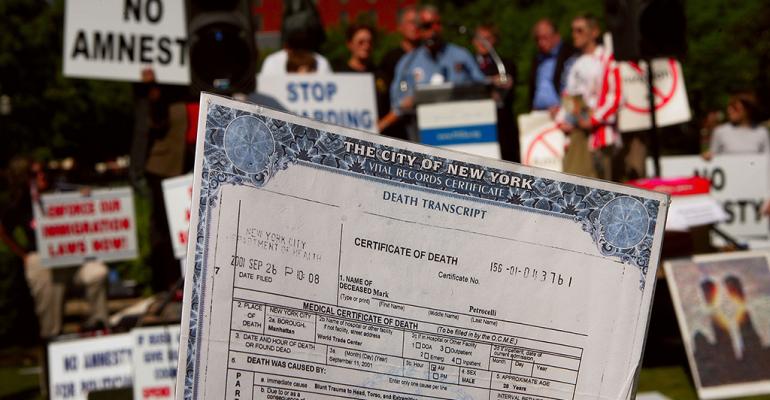In a prior article, I discussed the Surface Transportation and Veterans Health Care Choice Improvement Act (Act), which limits basis increase planning at the death of the surviving spouse. I concluded that an unnecessary qualified terminable interest property (QTIP) election on the death of the first spouse to die doesn’t allow a date-of-death (DOD) basis at the survivor’s death. However, some practitioners are promoting a method to obtain a DOD basis adjustment on the death of a surviving spouse, presuming, a DOD basis increase. This method is a combined portability/QTIP election. This election would arguably allow the property subject to it to be included in the surviving spouse’s estate and allow a DOD basis.1 The Internal Revenue Service is expected to issue advice in a forthcoming Internal Revenue Bulletin.
Revenue Procedure 2001-38
Rev. Proc. 2001-38 says that an unnecessary QTIP, that is, one not needed to reduce estate taxes at the death of first spouse to die, is “null and void.”
Updating Rev. Proc. 2001-38 to 2015, Treasury Decision 9275, issued June 16, 2015, provides, regarding Rev. Proc. 2001-38:
8. Effect of Portability Election on Application of Rev. Proc. 2001-38
Multiple commenters have requested guidance on the application of Rev. Proc. 2001-38, 2001-24 IRB 1335, when an estate makes a portability election under section 2010(c)(5)(A) as well as an election under section 2056(b)(7) to treat qualified terminable interest property (QTIP) as passing to the surviving spouse for purposes of the marital deduction. Rev. Proc. 2001-38 provides a procedure by which the IRS will disregard and treat as a nullity for Federal estate, gift, and generation-skipping transfer tax purposes a QTIP election made under section 2056(b)(7) in cases where the election was not necessary to reduce the estate tax liability to zero. The commenter notes that, with the introduction of portability of a deceased spouse's unused exclusion amount, an executor may purposefully elect both portability and QTIP treatment and the rationale for the rule voiding the election in Rev. Proc. 2001-38 (that the election was of no benefit to the taxpayer) is no longer applicable. The Treasury Department and the IRS intend to provide guidance, by publication in the Internal Revenue Bulletin, to clarify whether a QTIP election made under section 2056(b)(7) may be disregarded and treated as null and void when an executor has elected portability of the DSUE amount under section 2010(c)(5)(A). (Emphasis added)
I believe that the phrase “to clarify whether a QTIP election . . . may be disregarded,” doesn’t seem encouraging to those hoping that an election will grant a DOD basis adjustment for an unnecessary QTIP election.
Possible Solution
To obtain a DOD basis adjustment even if there’s an unnecessary QTIP election: 1) draft a trust that grants the surviving spouse a general power of appointment (Power), or (2) have a trust that may be construed to allow the grant of a Power to the surviving spouse. Because the Power technique doesn’t need a QTIP election, it doesn’t involve the previous statement in TD 9275.
Suggested Language to Include in Power
To make sure the Power is effective to avoid problems obtaining a DOD basis adjustment, it’s important to include certain language limiting the surviving spouse’s power. Start off by stating:
“If my spouse is the beneficiary of my trust, I grant the beneficiary of my trust the Power, subject to the following limitations.” Then, include these limitations on the Power.
1. Creditors as the Sole Appointees. State ”the only appointee is to the beneficiary’s creditors, which qualifies as a Power.”2 To prevent the spouse from exercising the Power, for whatever reason, a limitation may be imposed on the effectiveness of an attempted exercise.
2. Concurrence—State “the exercise of the Power must be concurred in by a nonadverse person, as defined in the Code,3 appointed by the Trustee for that purpose. I prefer my attorney be that nonadverse person, which is allowed for a Power.”4
3. No Estate Taxes—There’s the potential for a massive increase in the surviving spouse’s estate taxes, due to the inclusion of the decedent’s property in the surviving spouse’s estate. To deal with this problem, include language in the Power stating: “The property of my trust, over which the beneficiary has a Power, may not exceed an amount that would cause an estate tax of more than ten dollars ($10) to be due at the beneficiary’s death, as a result of this Power.”
4. Certain Assets—There are certain assets that shouldn’t be subject to the Power: (1) retirement accounts and other income in respect of a decedent,5 and assets that have decreased in value since the decedent’s death. To make sure these aren’t subject to the Power, include language that states: “The Power shall not be over any property that has an adjusted basis less than its fair market value, nor property that has decreased in value below its estate tax value at my death.”
5. Limitation on Power—Provide for a choice of assets if the assets included in the Power are limited to avoid estate taxes in the surviving spouse’s estate. The language should state: “ If the Power is limited in amount by item “No Estate Taxes, the Power shall be, to the extent allowed hereunder, allocated first, to properties in my trust that have the greatest difference between the property’s basis, subtracted from its fair market value, at the death of the beneficiary.”
Endnotes
1. Steve Liemberg’s Estate Planning Newsletter No. Archive Message #2100 (quoting Millbank, Tweed, Hadley & McCoy, LLP) 20-May 2013.
2. Internal Revenue Code Section 2041(b)(1).
3. IRC Section 672(c).
4. IRC Section 2041(b)(1)(C)(ii).
5. IRC Section 691.





